Items
topic_interest is exactly
risk
-
 2022-05-20
2022-05-20What Parents Need to Know About Sharing Breast Milk
This is a news story from The New York Times by Catherine Pearson. Due to the nationwide baby formula shortage, new methods of obtaining milk have come about. One of those ways is sharing extra breast milk. There is some risk involved in getting donor breast milk. Informal sharing means that it won't get checked for things like HIV or hepatitis B. There are some health benefits to using donor milk though. One of them is immunity to COVID. For example, mothers who have been infected with COVID or have received the vaccine can pass down those antibodies to babies through their milk. -
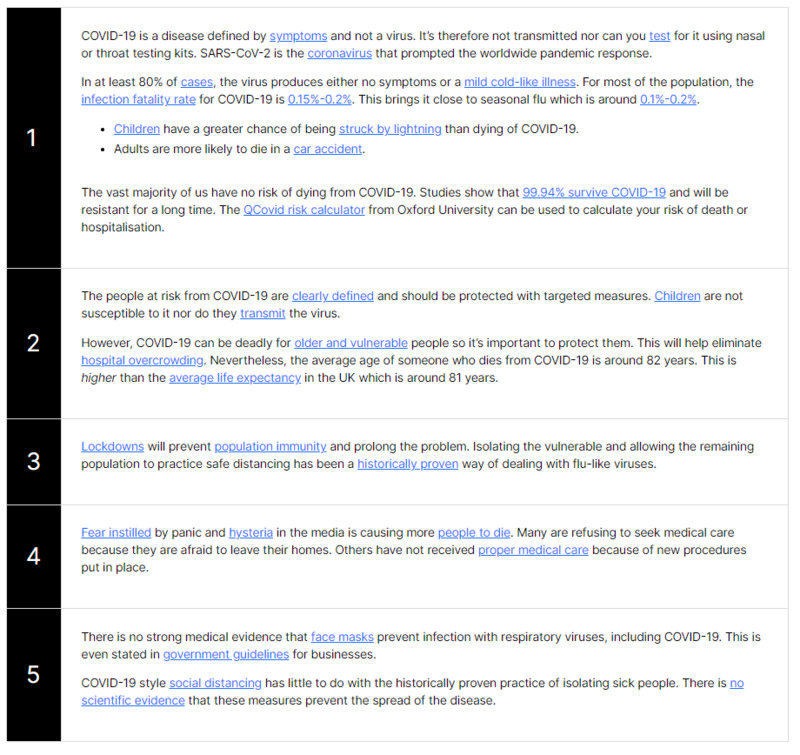 2022-05-10
2022-05-10Evidence Not Fear Key Facts Chart
The item is a chart from evidencenotfear.org. It can be found on the homepage. This chart can be found under the “key facts” section and explains the information that is claimed to be from experts in epidemiology, microbiology, and virology. The key facts section contains information that is immediately concerning to me. Some of the statements that are the most concerning to me are that children cannot transmit the virus, face masks can create negative health effects for the person wearing them, and more people have died from the panic of COVID-19 than the virus itself. The chart contains links, which I assumed would provide evidence and research to back up the claims. However, each link leads to an archive of news articles that are related to that topic. The message of this item is that the fear of COVID-19 has been worse than what the virus can actually do. This is seen through the explanations of face masks causing complications, lockdowns preventing herd immunity, and children cannot being affected by it. It tries to persuade the reader by providing links to several different news articles supporting the claim. However, the news article that they are using as support does not provide sources either. -
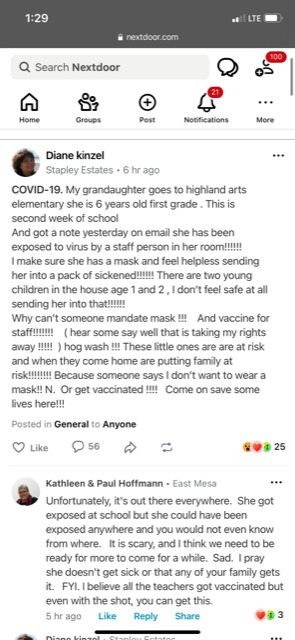 2021-08-11
2021-08-11Exposure to covid in the classroom
I came across this conversation on a neighborhood app (Nextdoor) of a grandmother pleading for masks and vaccines after learning that one of her grandchildren was exposed to the virus in the classroom. I added a bit of the thread as well to show the different opinions on the matter. -
 2021-04-23
2021-04-23hermit HERALD, ISSUE 111
Chauvin appeal -
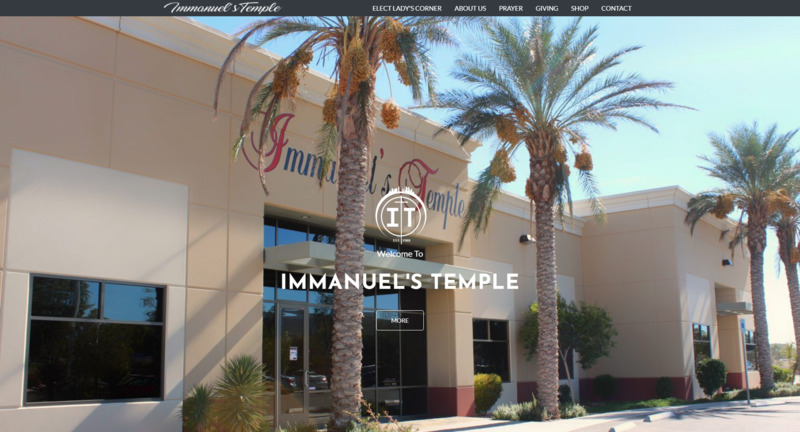 2020-03-15
2020-03-15Rest in a Time of Time of Unrest: COVID-19 Quaratine, Religion, and Public Life Reflection
My personal experience with COVID-19, My active involvement in my religious community and my public life reflection during times of a pandemic and political/ social unrest. -
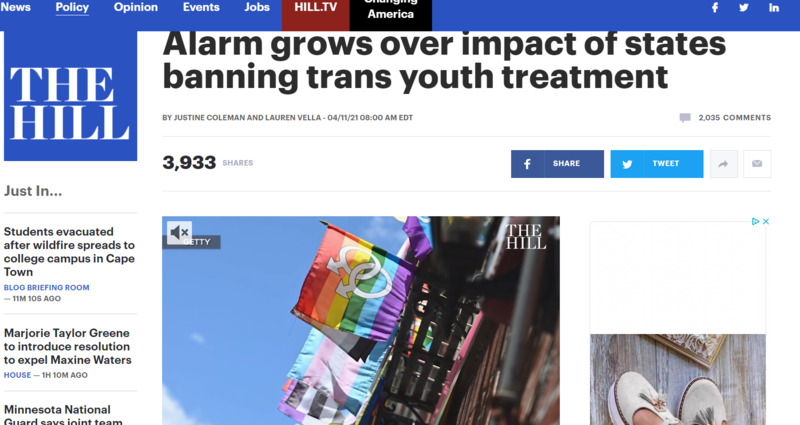 2021-04-11
2021-04-11Alarm grows over impact of states banning trans youth treatment
Medical experts and LGBT advocates are sounding the alarm over the physical and mental health risks to the transgender community after at least 19 state legislatures, including Arkansas, have proposed or passed bills seeking to ban trans youth treatment. Proponents of the bills have argued that the legislation is in place to protect children from making irreversible decisions about their bodies. But earlier this week, doctors and LGBT organizations defended treatments such as puberty blockers and hormone therapy, and warned about a potential increased suicide rate among trans youth if such legislation is enacted. -
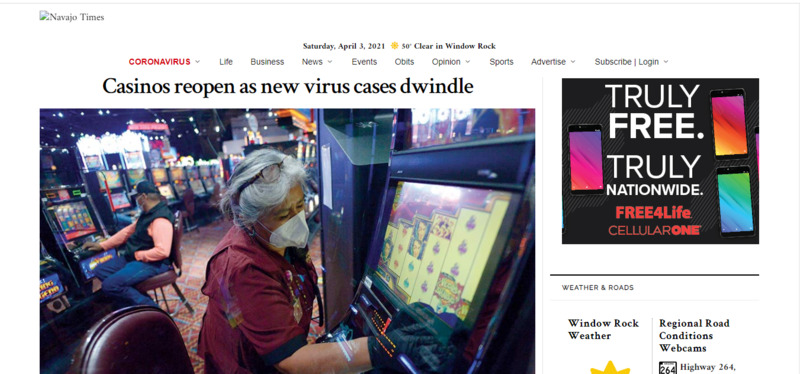 2021-03-25
2021-03-25Navajo Nation casinos reopen as new virus cases dwindle
By Donovan Quintero | Mar 25, 2021 | Business, CORONAVIRUS | CHURCH ROCK, N.M. Peterson Zah has a concern. On Tuesday, while hundreds of Fire Rock Casino patrons tried to win some money, the former Navajo Nation president wanted to hear what the COVID-19 public service announcement sounded like in Navajo. “I didn’t hear any of the PSA while inside because it’s so noisy,” he said. After taking a step outside the casino, the former Navajo Nation president said he was able to hear it. But that raised a concern for him. “And it’s pretty good,” Zah said, explaining the PSA in Navajo was clear and concise. “But you can only hear that clear outside and inside you can’t really understand it.” Zah said he was concerned no one would hear the COVID-19 safety guidelines everyone needed to follow. His other concern was that since many Navajo people have gotten both doses of the vaccines, many of them might become emboldened. “The reason why I was concerned is people have this attitude that because of the shots … they say, ‘Hey, I’m immune, I don’t have to worry about the virus.’ So when I go places I’m gonna take mine (mask) off,”’ Zah said Tuesday. According to the president’s office, more than 76,000 people have been fully vaccinated as of March 23 and more than 191,000 total doses have been administered. Zah didn’t think people should take any chances by easing up on protecting themselves from the contagious respiratory virus because some people were not wearing masks. After being closed for more than a year, Fire Rock Casino and Northern Edge Casino were on the fifth day of a two-week “soft reopening.” Just the gambling portion of the casinos were open at 25% capacity, and only Navajo Nation residents were allowed into the casinos, according to Navajo Gaming interim CEO Brian D. Parrish. Parrish clarified Navajo Nation residents meant everyone, including non-Natives, living on the reservation would have access to the casinos during the reopening phase. “We’re doing it with a two-phase reopening plan that started with Fire Rock and Northern Edge first,” he said. “We’re going to reevaluate with the Navajo Nation. They’re going to do audits and monitor our implementation of our workplace safety plan.” Of the 1,180 casino employees, 650 have returned to work since last Friday, said Parrish. Employees like Fire Rock Casino housekeeper Mildred Russell, who said she’s been out of work for over a year, were happy to be working again. “It’s been a struggle,” Russell said while cleaning a slot machine last Friday. “Hopefully this pandemic will be gone and everybody can go back to their normal lives.” Other employees, like casino security officer Vernon Keeswood from Hogback, New Mexico, shared Russell’s gratitude for getting the call to go back to work. “It’s good,” he said on Tuesday during a telephone interview that was arranged by Michele J. Crank, executive director of communications and public relations for Navajo Nation Gaming Enterprise. Instead of the usual hugs and shaking hands, Keeswood said, now it was “fist bumps” and “elbow bumps.” As for the reopening, he said many Northern Edge Casino customers “are pleased and happy” the Navajo casinos have begun reopening. He added a few customers were not sure if the casinos should reopen. “I hope everyone washes their hands and practices social distancing so we open to 100 percent capacity,” Keeswood said. “I hope it opens more.” After all, the threat of another COVID-19 outbreak looms on everyone’s mind, including that of Robert Peterson from Thoreau. “People are still afraid to come here but a lot of them want to enjoy being out instead of being stuck at home,” said Peterson, who said he lives alone, last Friday. Peterson said being alone and dealing with the pandemic has been hard for him. Despite his fears, he decided to head to Fire Rock to get his mind off COVID-19. Mary E. Silversmith, 79, from Lupton, Arizona, ensured no one came to visit her with a “no visitors allowed” sign posted on her hogan. She was happy to support the casino employees who returned to work. “The casinos were opened for the casino employees,” she said on Tuesday at Fire Rock. “Many of have children and they have bills to pay. “Because of that, I am OK with the reopening,” she said. “Some people have been criticizing the reopening. Not me, I don’t think that way or talk that way.” Before the pandemic, Silversmith said she frequently ate at Fire Rock, as well as at Twin Arrows Casino and Resort, when she had extra money to spend. Silversmith was wearing a surgical mask. To gain entry into both casinos during the soft reopening, a state ID, like a driver’s license, is required and a working number at which customers can be contacted. Temperature checks were also part of the requirements for anyone wanting to enter. After their temperature was checked, security asked customers to momentarily remove their masks and look at the front entrance security camera. The purpose of collecting all of the information is for contact tracing, said Parrish. “We have an excellent plan that’s in place,” he said. “We’ve had it reviewed and modified and enhanced by public health experts, not only on Navajo, but outside the Navajo Nation.” He added that Navajo Gaming invested close to $2 million in “equipment, supplies, signage, training,” to keep everybody safe. U.S. Indian Health Service officials toured both of the casinos’ kitchens on March 12, Parrish added, to review their safety procedures. “And in terms of reopening of the other properties, especially at a higher capacity percentage, that’s going to be based not only on how well the enterprise does, but what’s happening with the public health metrics, the rate of vaccinations on Navajo and other key indicators like that,” the interim CEO said. The Navajo Gaming enterprise’s careful planning even got praise from Jordan Schermerhorn, a senior research associate at Georgetown Center for Global Health Science and Security. Schermerhorn stated in an email to NNGE their plan showed the tribe was leading “the entire country in a smart, careful return to normalcy.” “Combined with the Navajo Nation’s outstanding vaccine rollout, this soft reopening shows what is possible with a data-driven pandemic response in a community dedicated to public safety,” Schermerhorn‘s email said. Even the ventilation, air conditioning and heating systems, which completely re-circulate the air inside the casinos 15 times a day, were reviewed, said Parrish. “We’re ready to go to fifty percent, we’re ready to offer food and we’re ready to bring the rest of our team back,” Parrish said. Zah watched casino patrons trying to win money as sounds from the Tuesday afternoon hustle and bustle all but drowned out the COVID-19 PSA. “So basically, the attitude shouldn’t be such now that because they got their shot they don’t have to worry about it,” he said. “It’s still around. Even though ninety percent of the people may be wearing their mask, or all of them, if one of them comes in that has it, then we’re in trouble.” Zah explained a new COVID-19 variant is much smaller than the original strain, which to him was why everyone needed to double mask. “If you can see light through your mask that means it’s gonna go through,” Zah said. “We gotta start wearing two masks.” He said he intends to go on KTNN and remind everyone not to run off to Phoenix or Albuquerque just because they’ve been vaccinated. “At the same time, they still have to follow those protocols,” he said. “I want to say, ‘You gotta start wearing double masks.’” As of Tuesday night, the Navajo Nation Department of Health reported a cumulative 30,010 cases of the virus and 1,233 deaths. -
2020-05-01
Group of Risk
I have epilepsy and I take medicine for it, this medicine lowers my immune system, so I am considered a group of risk for convid, my life got very limited because of that, also because of my seizures I can't have a drivers license, so I was the only one in my family that couldn't get out for the small chance I would catch convid in the uber passenger seat, or in my way to the tabaco store, I stayed 5 months in my house without being able to go outside. The depression was horrible, but when things got a little better I could TAKE MY DOG FOR A WALK. -
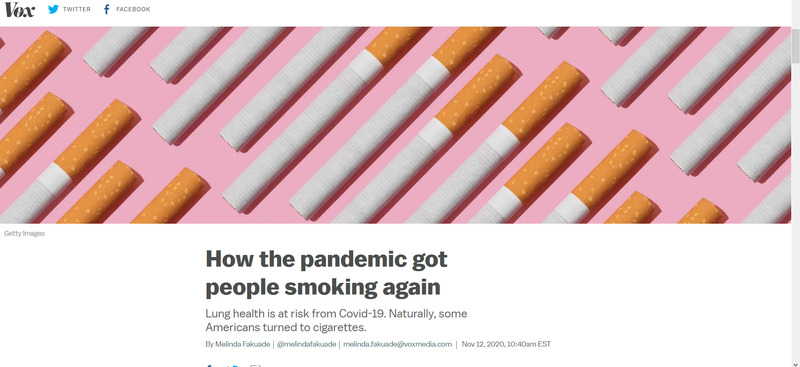 2020-11-12
2020-11-12"How the pandemic got people smoking again" - Vox
With the advent of the COVID-19 pandemic, many people have been pressured to develop bad habits such as overeating, alcoholism, doom scrolling, and impulse shopping. But one pandemic indulgence that stands out to medical officials and journalists is smoking, which damages lungs and puts one at an increased risk from dying of COVID-19. In an article for Vox, journalist Melinda Fakuade provides readers with an overview of the reasons why more people have taken up smoking during the COVID-19 pandemic in spite of the increased risk of death. According to Fakuade, a major factor that explains the increased prevalence of smoking during the COVID-19 pandemic is the sheer boredom that comes with being unable to leave home without risking contracting COVID-19. Not being able to leave home and spend money on other amenities also increases one's access to discretionary spending, which can be used to fund cigarette smoking and other bad habits. Fakuade also emphasizes the role of stress, which induces people to take up bad habits such as smoking as a coping mechanism. According to her, smoking functions as a way of maintaining a routine and sense of control in a time of extreme instability. Finally, Fakuade considers whether or not the increased prevalence of smoking during the COVID-19 pandemic constitutes a reflection of an internal "death wish," on the part of smokers. -
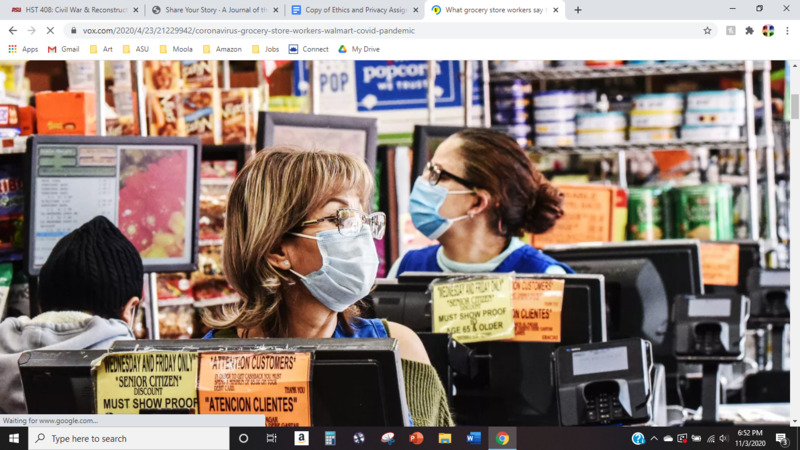 2020-04-23
2020-04-23What grocery store workers say they’re facing during the pandemic.
This article is important to share because although I was not a Wal-Mart employee through the pandemic, the employees interviewed in the article are relatable as the company has never been proactive and instead reactive. While I understand that no one was prepared for the pandemic, the way the employees were treated during this time was very typical to the way our store employees were treated, and still are, in situations where health is being risked for the sake of a sale. “The manager’s response, according to Hall: “Wash your hands every 15 minutes, so you don’t need a glove or a mask.” ‘She just walked away from me and started laughing, like it was funny.’ Hall said.” The article also goes on to state that it wasn’t until employees began speaking out against conditions and fear for their own safety due to the company’s lack of procedures and precautions, that they started implementing safety precautions for customers and employees. -
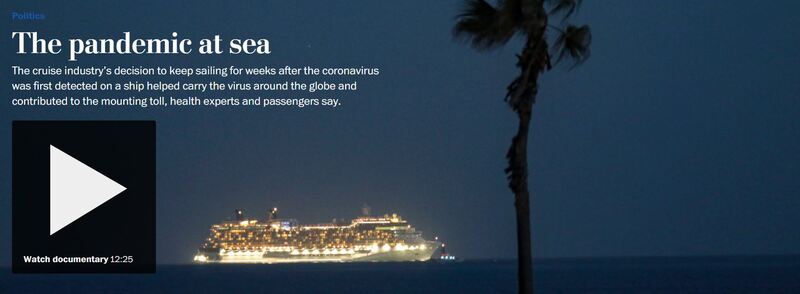 2020-04-25
2020-04-25Did Cruise Companies Act too Late?
All it took was one passenger who disembarked a week before others began to fall ill, to quarantine all passengers and crew on the Diamond Princess by February 4th. Given the dire nature of these outbreaks, many have asked – did the cruise companies act too late? This Washington Post article outlines the experiences of the Celebrity Eclipse and Coral Princess, where before passengers could disembark, the two ships reported 150 Covid-19 cases and six deaths in April. At the time the article was written, the cruise industry reported outbreaks on 55 ships in waters across the globe and 65 deaths among passengers and crew. The article alleges that the industry failed to recognize the signs and symptoms of Covid-19, which later were confirmed as positive cases. Further concerning allegations from the article claim that cruise ships brought Covid-19 to ports and cities around the globe that were otherwise virus-free, where many places lacked the infrastructure to handle large-scale outbreaks. -
 2020-08-07
2020-08-07CDC Rates Cruise Ships for Sanitation and Cleanliness
Cruise ships are bustling cities. Lido decks are a din of conversation over food, and while most cruise ships suspended buffets years ago, passengers still share access to, among others, refillable water stations, cookie baskets, and salt and pepper shakers. Tables are close together and guests stand closely in line. While hand sanitizer stations are dotted throughout common areas, cruise ships with so many people in such close quarters, are difficult places to prevent the spread of aerosol, airborne virus’ like Covid-19. Now that cruise ships, and world health organizations, have had time to assess the risk they are developing new protocols to help making cruising possible again when it is safe to do so. The United States’ Centers for Disease Control and Prevention developed the Vessel Sanitation Program, which is now shifting to include Covid-19 health protocols. Ships receive a surprise inspection from the CDC where they evaluate the following areas: medial facilities, potable water systems, swimming pools and whirlpool spas, galleys and dining rooms, child activity centers, hotel accommodations, ventilation systems, and common areas of the ship. At The Points Guy blog, they outline how the program works and how future cruisers can use the CDC data to inform the health and safety of their future vacation. -
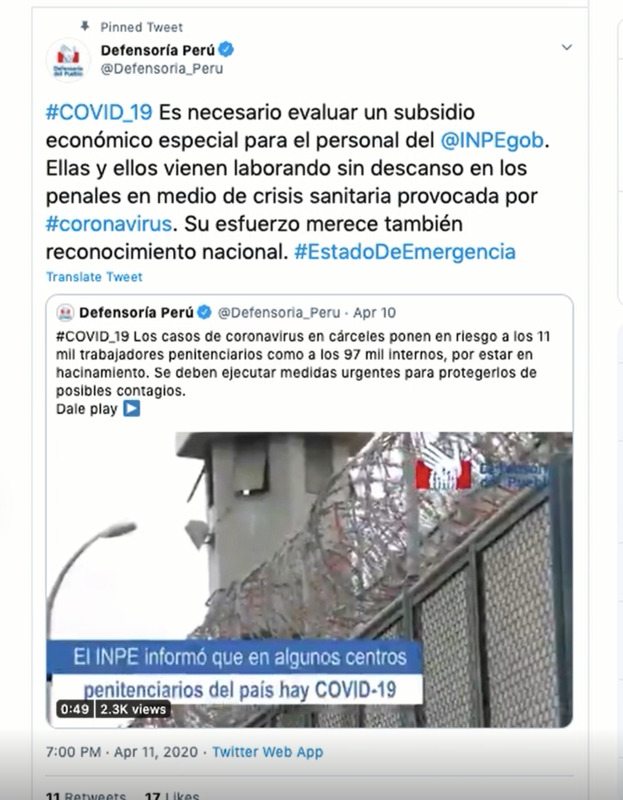 2020-04-11
2020-04-11Call for economic subsidy for Peru's prison & jail employees
#COVID_19 Es necesario evaluar un subsidio económico especial para el personal del @INPEgob. Ellas y ellos vienen laborando sin descanso en los penales en medio de crisis sanitaria provocada por #coronavirus. Su esfuerzo merece también reconocimiento nacional. #EstadoDeEmergencia
